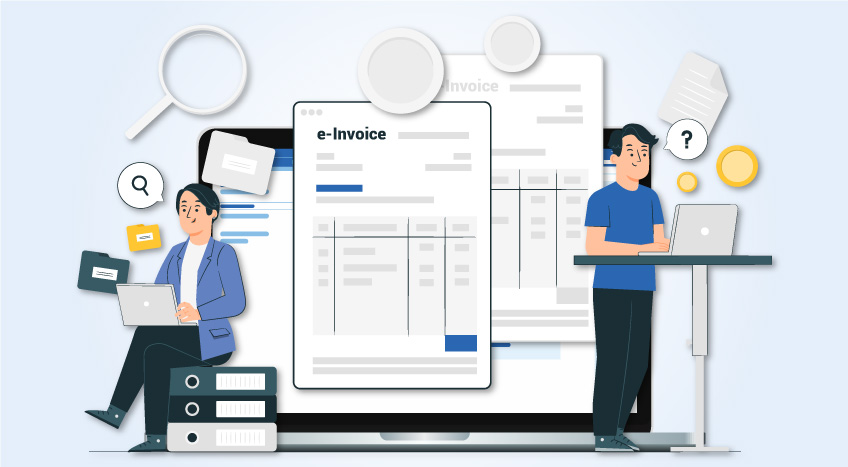The enforcement of e-invoicing phase one (the generation phase) in Saudi Arabia started on December 4, 2021, applicable to all taxpayers who are subject to e-invoicing regulations. In this first phase, all compatible businesses must generate and store electronic invoices in specific specs and formats instead of traditional old invoices.
This huge transformation in the Saudi economy towards the digital era provides businesses with many benefits, including fair competition, secure financial data, and much more.
The 2nd phase of e-invoicing, also known as the integration phase of invoicing, shall start by January 1, 2023, according to the announcement of The Saudi Zakat, Tax, and Customs Authority (ZATCA).
ZATCA aims to enforce taxpayers connecting and integrating their e-invoice generating solutions and devices with the Fatoora portal for validation, clearance, and other features and transactions needed in the 2nd phase of invoicing.
The integration phase will be implemented in phases and will be mandated to persons subject to the e-invoicing regulations based on a specific set of criteria determined by the authority. In the first wave, integrated e-invoicing will be implemented for businesses with taxable turnover above 3 billion Saudi Riyals in the calendar year 2021. This will be applicable from 1st January,2023. The second phase will apply to businesses with revenue exceeding 500 million in FY 202 from 1st July,2023.
While it will be extended to the remaining business gradually, it is crucial for businesses to know how the integration phase of e-invoicing works. In this blog, we have explained the workflow that will help businesses get a fair idea of the e-invoicing concept.
|
The 2nd Phase- Integration phase of e-invoicing in Saudi Arabia |
How does the 2nd phase of e-invoicing work?
Before we get to know the workflow of the e-invoice concept, it is important to note that there are 2 key participants of the e-invoicing system. First is the business software such as accounting software/ERP and the second is ZATCA's e-invoice portal. Between these 2, there will be continuous interaction in the process of generating the e-invoice. Given that there are 2 types of invoices – tax invoice and simplified invoices- the e-invoicing process for each of these invoices is slightly different, as explained below. Let's start with step-by-step details that explain how the e-invoicing system works.
Electronic Tax Invoice
- The e-Invoicing process starts with the supplier generating the invoice XML in the prescribed format using the business software
- The invoice XML generated by the business software will share to e-invoicing portal on a real-time basis for the clearance purpose
- In the clearance stage, the e-invoicing portal validates the invoice details reported by the supplier.
- If the details are successfully verified, the e-invoicing portal authenticates the invoice with cryptographic stamps and QR code details.
- Once the invoice details are stamped, the e-invoicing portal sends the details such QR Code, Unique invoice number etc. to the supplier's business software
- Next, the supplier's software adds the QR code and other details on the invoice and issues it to the buyer. In addition, the e-invoices must be stored electronically as mandated during the first stage of e-invoicing.
Simplified e-invoicing
Unlike tax invoice, which requires real-time sharing and clearance from the portal, simplified e-invoicing can be authenticated by the business software itself. Therefore, the business's software solution must be compliant and registered with the portal for generating simplified e-invoices. Once the software is registered, here is how simplified e-invoicing work.
- Supplier generates the simplified invoice (B2C) using the compliant software solution such as ERP, accounting software etc. registered with the portal
- The software stamps the invoice with a QR code and generates a unique invoice number.
- Next, the supplier prints the invoice with QR code and issues it to the buyer
- Within 24 Hrs., the supplier must report such simplified invoices to the e-invoicing portal. It's important to note that there is no clearance process, it's just the reporting of simplified invoices.
- Once the invoices are reported, the portal validates the details and electronically acknowledges them to the supplier
How can TallyPrime help?
TallyPrime is a complete business management software that is accredited by Zakat and Tax authority ZATCA as a compliant e-Invoicing (FATOORA) software. TallyPrime fully supports the phase -1 of e-invoicing and will be enhanced to support the integration phase.
- TallyPrime is designed to archive the invoice details in XML format as per ZATCA requirements
- Generate e-invoice for tax invoices and simplified invoices in a single click
- Supports e-invoices for a tax invoice, simplified invoice, debit notes, and credit notes
- Print QR codes on simplified invoices effortlessly
- Accurate VAT returns filing
- An exclusive e-invoice report will give you a view of all e-invoicing tasks, activities, and complete history of transactions
- Security control and User login management
- Log details indicating the entire history of the masters & transactions
Explore more Products









